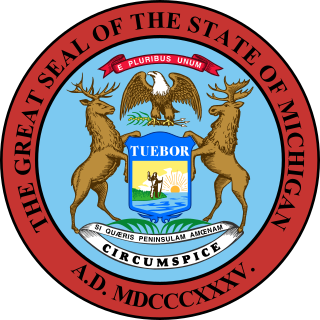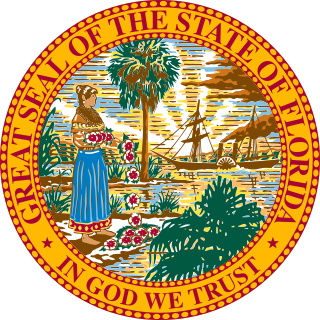
The United States Congress is the bicameral legislature of the federal government of the United States, and consists of two chambers: the House of Representatives and the Senate. The Congress meets in the United States Capitol in Washington, D.C. Both senators and representatives are chosen through direct election, though vacancies in the Senate may be filled by a gubernatorial appointment. Congress has 535 voting members: 435 representatives and 100 senators. In addition, the House of Representatives currently has six non-voting members, bringing the total membership of the US Congress to 541 or fewer in the case of vacancies.
A bicameral legislature has legislators in two separate assemblies, chambers, or houses. Bicameralism is distinguished from unicameralism, in which all members deliberate and vote as a single group, and from some legislatures that have three or more separate assemblies, chambers, or houses. As of 2015, fewer than half the world's national legislatures are bicameral.

The Minnesota Senate is the upper house of the Legislature of the U.S. state of Minnesota. At 67 members, half as many as the Minnesota House of Representatives, it is the largest upper house of any U.S. state legislature. Floor sessions are held in the west wing of the State Capitol in Saint Paul. Committee hearings, as well as offices for senators and staff, are located north of the State Capitol in the Minnesota Senate Building. Each member of the Minnesota Senate represents approximately 80,000 constituents.

The Michigan Legislature is the legislature of the U.S. state of Michigan. It is organized as a bicameral body composed of an upper chamber, the Senate, and a lower chamber, the House of Representatives. Article IV of the Michigan Constitution, adopted in 1963, defines the role of the Legislature and how it is to be constituted. The chief purposes of the Legislature are to enact new laws and amend or repeal existing laws. The Legislature meets in the Capitol building in Lansing.

The Virginia General Assembly is the legislative body of the Commonwealth of Virginia, and the oldest continuous law-making body in the New World, established on July 30, 1619. The General Assembly is a bicameral body consisting of a lower house, the Virginia House of Delegates, with 100 members, and an upper house, the Senate of Virginia, with 40 members. Combined together, the General Assembly consists of 140 elected representatives from an equal number of constituent districts across the commonwealth. The House of Delegates is presided over by the Speaker of the House, while the Senate is presided over by the Lieutenant Governor of Virginia. The House and Senate each elect a clerk and sergeant-at-arms. The Senate of Virginia's clerk is known as the "Clerk of the Senate".

The Connecticut General Assembly (CGA) is the state legislature of the U.S. state of Connecticut. It is a bicameral body composed of the 151-member House of Representatives and the 36-member Senate. It meets in the state capital, Hartford. There are no term limits for either chamber.

The Florida Legislature is the legislature of the U.S. State of Florida. It is organized as a bicameral body composed of an upper chamber, the Senate, and a lower chamber, the House of Representatives. Article III, Section 1 of the Florida Constitution, adopted in 1968, defines the role of the legislature and how it is to be constituted. The legislature is composed of 160 state legislators. The primary purpose of the legislature is to enact new laws and amend or repeal existing laws. It meets in the Florida State Capitol building in Tallahassee.

The California State Assembly is the lower house of the California State Legislature, the upper house being the California State Senate. The Assembly convenes, along with the State Senate, at the California State Capitol in Sacramento.

The California State Senate is the upper house of the California State Legislature, the lower house being the California State Assembly. The State Senate convenes, along with the State Assembly, at the California State Capitol in Sacramento.

The Parliament of the Democratic Socialist Republic of Sri Lanka is the supreme legislative body of Sri Lanka. It alone possesses legislative supremacy and thereby ultimate power over all other political bodies in the island. It is modeled after the British Parliament.

The North Dakota Legislative Assembly is the state legislature of the U.S. state of North Dakota. The Legislative Assembly consists of two chambers, the lower North Dakota House of Representatives, with 94 representatives, and the upper North Dakota Senate, with 47 senators. The state is divided into 47 constituent districts, with two representatives and one senator elected from each district. Members of both houses are elected without term limits. Due to the Legislative Assembly being a biennial legislature, with the House and Senate sitting for only 80 days in odd-numbered years, a Legislative Council oversees legislative affairs in the interim periods, doing longer-term studies of issues, and drafting legislation for consideration of both houses during the next session.

The National Congress of Brazil is the legislative body of Brazil's federal government. Unlike the state legislative assemblies and municipal chambers, the Congress is bicameral, composed of the Federal Senate and the Chamber of Deputies. The Congress meets annually in Brasília from 2 February to 22 December, with a mid-term break taking place between 17 July and 1 August.
In United States politics, a ranking member is the most senior member of a congressional or state legislative committee from the minority party. On many committees the ranking minority member, along with the chairman, serve as ex officio members of all of the committee's subcommittees.

The Senate is the upper house in the bicameral Parliament of Romania. It has 136 seats, to which members are elected by direct popular vote using party-list proportional representation in 43 electoral districts, to serve four-year terms.

The Kentucky General Assembly, also called the Kentucky Legislature, is the state legislature of the U.S. state of Kentucky. It comprises the Kentucky Senate and the Kentucky House of Representatives.

David Scott Dibble is an activist, Minnesota politician, and member of the Minnesota Senate. As a member of the Minnesota Democratic–Farmer–Labor Party (DFL), he represents District 61, which includes portions of the city of Minneapolis in Hennepin County.

Hillman Terome Frazier is an American politician who is a Democratic member of the Mississippi Senate; he has represented the 27th District since 1993. A Protestant, he is married to the former Jean Clayton. From 1980 until 1993 he served in the Mississippi House of Representatives; he has also previously participated in Leadership Jackson. Eisenhower Fellowships selected Hillman Terome Frazier as a U.S.A. Eisenhower Fellow in 1998.
Jason Isaacson is a Minnesota politician and member of the Minnesota Senate. A member of the Minnesota Democratic–Farmer–Labor Party (DFL), he was elected to the Minnesota Senate in 2016, after serving in the House for four years. He represents District 42 in the central Twin Cities metropolitan area; Jason's top issues include creating living wage jobs for Minnesotans and expanding job skills, and he is an advocate for affordable housing for all. He represents Senate District 42 which includes Arden Hills, Gem Lake, Little Canada, Mounds View, Shoreview, Vadnais Heights, and parts of Roseville, Spring Lake Park, and Blaine. He previously represented District 42B in the Minnesota House of Representatives.

Melissa Halvorson Wiklund is a Minnesota politician and member of the Minnesota Senate. A member of the Minnesota Democratic–Farmer–Labor Party (DFL), she represents District 50 in the southern Twin Cities metropolitan area, which includes the cities of Bloomington and Richfield. Senator Wiklund's legislative priorities include education, health care, and job creation.















